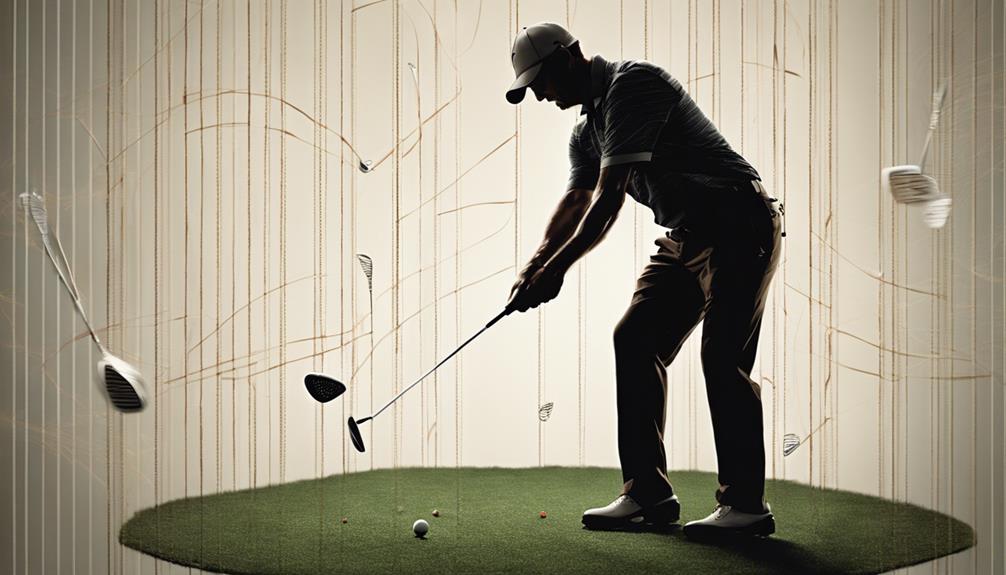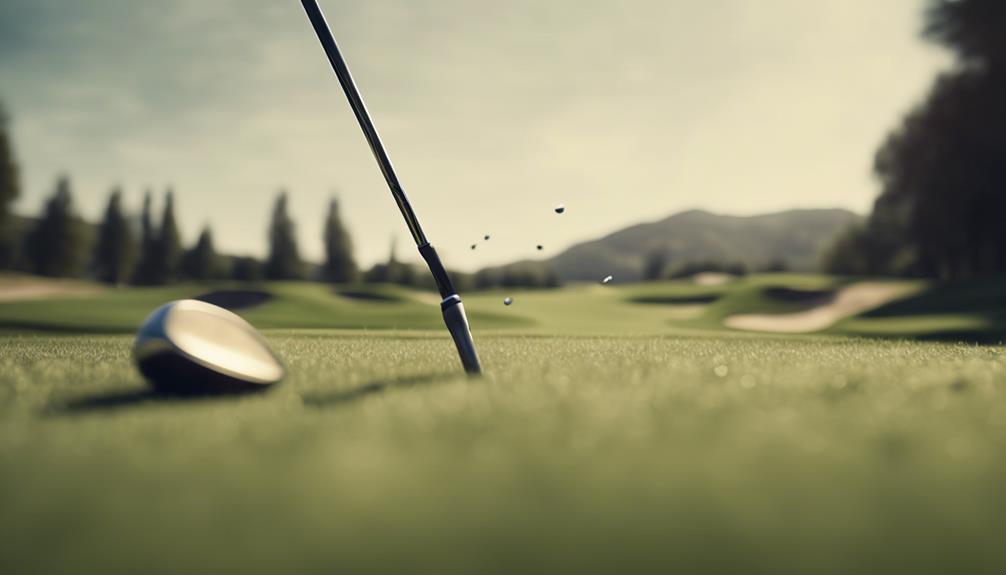- 7 Top Flite Golf Clubs XL for Improved Performance - September 28, 2024
- Top Flite Golf Clubs: Top 5 Reasons to Choose Them - September 28, 2024
- Top 3 Golf Club Fitters for a Perfect Swing - September 28, 2024
When it comes to typical distances for golf clubs, you'll want to evaluate your swing speed, clubhead speed, and smash factor. Generally, drivers range from 230-260 yards, 3-woods cover 215-235 yards, and irons decrease in distance as they increase in number, with 4-irons reaching around 170-185 yards and pitching wedges covering 105-120 yards. Keep in mind that environmental factors like wind, temperature, and turf conditions can impact your shots. Understanding these variables and your personal average distances will help you choose the right club for each shot – and as you explore these factors further, you'll reveal even more secrets to maximizing your distance.
Key Takeaways
- Average distances for golf clubs vary by club type, with drivers ranging from 230-260 yards, and irons and wedges covering shorter distances.
- A golfer's swing speed, clubhead speed, and smash factor significantly impact the distance achieved with each club.
- Environmental factors like wind, temperature, and turf conditions also affect golf ball performance and distance.
- Understanding personal average distances for each club can guide club selection and improve overall game performance.
Understanding Golf Club Distance
As you step up to the tee, understanding the complex interplay of factors that influence golf club distance becomes essential to enhancing your game.
To achieve ideal golf club distances, you need to reflect on the intricate relationships between swing speed, clubhead speed, and smash factor. The smash factor, in particular, plays a significant role in determining the distance achieved, as it's the ratio of ball speed to clubhead speed.
For instance, a higher clubhead speed can result in a greater driver distance, but only if combined with an ideal smash factor. Additionally, understanding your individual average distances is critical in selecting the right clubs for your game.
A thorough club fitting can help you identify the perfect clubs to maximize your distance potential. By grasping these fundamental principles, you'll be better equipped to fine-tune your technique, make informed club selections, and ultimately, improve your overall game.
Average Distances by Club Type
You can expect to achieve specific distances with each club type, with the driver typically yielding the longest shots and wedges producing the shortest.
As a golfer, understanding these typical distances is essential in selecting the right club from your golf club sets. According to club distance charts, the average golf club distance for a driver ranges from 230 to 260 yards, depending on your driver swing speed.
A 3-wood, or fairway wood, typically sends the ball between 215 and 235 yards on average. For mid-handicap male golfers, a 4-iron can be expected to reach distances of 170 to 185 yards, while a 5-iron averages around 160 to 170 yards.
When it comes to wedges, a pitching wedge generally achieves distances between 105 and 120 yards.
These typical distances serve as a benchmark for golfers to improve their game. By knowing the average distances for each club type, you can refine your club selection and enhance your overall performance on the course.
Factors Affecting Distance Measurement

When you're measuring golf club distances, it's crucial to take into account the factors that can affect your readings.
You'll need to account for the limitations of tools like Trackman, which can provide inaccurate measurements due to rollout adjustments and unrealistic specifications.
Additionally, you'll want to factor in the differences between hitting bays and real course conditions, which can also impact your distance measurements.
Trackman Inaccuracies
As you rely on launch monitors like Trackman for distance measurements, you should be aware that factors like adjusted rollout and specific equipment settings can compromise the accuracy of these devices, leading to unreliable distance measurements.
When using Trackman, you might get inaccurate readings due to the artificial environment, which doesn't replicate real grass conditions. This can affect how the golf ball interacts with the ground, altering the distance measurements.
Additionally, environmental conditions such as wind and temperature can notably impact the performance of the golf ball, leading to discrepancies in distance readings.
To get a more accurate picture of your actual performance, reflect on utilizing tracking tools like GPS devices or club sensors during actual play. These tools can provide more reliable distance measurements compared to controlled environments.
Hitting Bay Limitations
Hitting bays, which often rely on launch monitors like Trackman, can also compromise distance measurements due to the artificial surface of the mats, which can alter the ball's behavior upon impact.
When you're hitting the ball on these mats, the ball striking isn't replicating real-world conditions, leading to discrepancies in distance. For instance, the grass lie on a course can notably affect both carry and roll distance, but hitting bays can't account for this.
Additionally, launch monitors may adjust rollout distances based on preset specs, resulting in inflated or deflated readings. This means you might experience discrepancies in distance measurements between hitting bays and actual course play.
To get accurate assessments, it's crucial to track your shots on the course, where you can factor in your average swing speed and other variables. Relying solely on hitting bay data can lead to a misunderstanding of your personal average distances.
Course Conditions Impact
Course conditions greatly alter the distance a golf ball travels, and understanding these factors is essential for refining your shot selection and strategy. You need to take into account the type of turf and surface moisture, as dry courses typically provide more roll than wet courses, affecting the distance you hit.
Wind conditions are also vital, as strong headwinds reduce overall distance, while tailwinds can add yards to a shot. The altitude of the golf course is another significant factor, with higher elevations generally allowing for longer distances due to thinner air resistance. Temperature also plays a role, with warmer air leading to increased ball speed and carry, while colder temperatures may shorten distances.
To accurately track your distances, utilize golf GPS devices or launch monitors. These tools help you adapt your strategies based on prevailing course conditions. With modern clubs, you can take advantage of the latest technology to optimize your game.
Finding the Right Club for You
You need to pinpoint your personal average distances for each club to make informed decisions about which one to use during a round, as this knowledge helps you navigate various scenarios and shot selections.
To determine the distance, consider your swing speeds, similar to LPGA tour players who optimize their club speed for maximum performance. As an average male amateur golfer, you can use the benchmark of driving the ball approximately 217 yards to assess your own distance capabilities with different clubs.
Utilizing modern technology, such as GPS devices or launch monitors, can help you accurately track your distances for each club, leading to better club choices on the course. Additionally, custom club fitting can optimize your golf equipment based on individual swing characteristics, potentially increasing swing speed by 2-5 mph and improving distance consistency.
Key Factors to Achieve Distance

By understanding the interplay between swing speed, carry distance, and environmental factors, golfers can access the full potential of their clubs and maximize distance. Your swing speed plays a significant role in determining total distance, with faster swings resulting in longer shots.
Carry distance, which measures the distance from impact to the ball's landing point, is also essential in understanding overall performance. However, factors that influence distance, such as weather conditions like wind and temperature, can't be ignored.
The loft of a specific golf club also plays a fundamental role in determining trajectory and distance, with lower lofts typically yielding longer hits. To optimize distance potential, you need consistent practice and technique refinement.
Focus on refining your swing to achieve a faster swing speed, and pay attention to the club face's angle of impact. By mastering these elements, you'll be able to access the full potential of your clubs and achieve greater distances.
Average Golf Club Distances Chart
When selecting the right club for a shot, golfers need to contemplate the average distances they can expect from each club in their bag. This chart provides a general guideline for golfers to reference when trying to determine the right club for a specific shot.
For instance, you can expect your driver to hit the ball around 230-260 yards on average, while your 3-wood will cover around 215-235 yards. As you move into your irons, your 4-iron will typically hit around 170-185 yards, and your 5-iron will cover around 160-170 yards. Your pitching wedge will usually cover 105-120 yards.
Understanding these average distances will help improve your game by allowing you to select the right club for each shot. By knowing how far you can hit each club, you'll be able to better navigate the driving range and course.
Improving Your Golf Club Distance

To take your game to the next level, you'll want to focus on optimizing your swing speed, as it's a critical factor in revealing more distance with each club.
You'll also need to understand smash factor, which is the ratio of ball speed to clubhead speed, and how it impacts your overall distance.
Optimizing Swing Speed
As you endeavor to maximize your golf club distance, focusing on optimizing your swing speed is essential, since even a slight increase in velocity can greatly impact your overall performance.
To carry the ball further, you need to hit the ball with more power, which requires a faster swing speed. On average, PGA Tour drivers reach speeds of around 113 mph, resulting in a carry distance of 275 yards.
You can improve your swing speed by 2-5 mph through proper equipment fitting, choosing the right golf clubs that match your individual attributes. Additionally, core strength exercises like sit-ups and planks can greatly enhance your swing power, leading to increased club distances.
Using lighter clubs can also help you generate higher swing speeds, directly correlating to longer shot distances. By practicing consistent swing mechanics and timing, you can maximize the efficiency of the golf club's sweet spot, resulting in improved ball speed and distance outcomes.
Understanding Smash Factor
By grasping the concept of smash factor, you can access significant improvements in your golf club distance, particularly with drivers, where refining this metric is essential for maximizing your overall performance.
Smash factor is calculated by dividing the ball speed by the clubhead speed, with a prime smash factor for drivers typically being 1.50, indicating efficient energy transfer. PGA Tour golfers achieve an average smash factor of 1.49 for drivers, showing the importance of maximizing this metric for better distance. A lower smash factor indicates less energy is transferred to the ball, while a higher smash factor results in greater distance for the same swing speed.
To improve your smash factor, focus on refining your swing mechanics to strike the sweet spot more consistently. As loft increases, the smash factor generally decreases; for example, the prime smash factor for a 7-iron is around 1.33.
By refining your smash factor, you can access significant gains in golf club distance. Focus on improving your energy transfer and striking the sweet spot to take your game to the next level.
With a better understanding of smash factor, you'll be able to fine-tune your swing and access the full potential of your golf clubs.
Frequently Asked Questions
How Far Should a Man Hit a 7 Iron?
When you hit a 7 iron, your distance accuracy depends on your swing mechanics, player skill, and age factors, as well as course conditions and loft effects, so focus on refining your practice techniques to optimize your shot.
What Is the Average Distance per Club for a Man?
'As the old adage goes, 'golf is a game of inches,' and mastering average club distances is essential. You'll find that distance variations depend on swing efficiency, club performance, player skill, age, terrain, and equipment quality, making each club's sweet spot unique.'
What Is Standard Golf Club Lengths?
You should know that standard club lengths vary, with men's clubs averaging 1 inch longer than women's, while youth club sizes and custom fitting cater to individual needs, alongside adjustable and hybrid designs, vintage measurements, and international standards.
What Swing Speed Do You Need to Hit 250 Yards?
'You're revving up to hit 250 yards, but it's like trying to ignite a rocket without fuel – you need a swing speed of around 105 mph to blast off, requiring precise distance control, ideal club fitting, and a perfect storm of ball speed, launch angle, and impact position.'
Conclusion
As you tee off, envision a trajectory of precision, your ball soaring through the air like a bird in flight.
Mastering golf club distances is key to revealing a consistent, powerful game.
With the right club in hand, you'll be able to navigate the course with confidence, your shots dropping like pins in a perfectly choreographed dance.
By understanding the typical distances for each club, you'll be well on your way to shaving strokes off your score and elevating your game to new heights.




